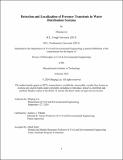| dc.description.abstract | Water distribution systems are critical to urban water supply, but as they age they become increasingly vulnerable to bursts and leaks, leading to significant economic, social, and environmental consequences. The complexity and inaccessibility of underground pipelines present substantial challenges for their maintenance. As a result, the development of real-time monitoring systems for these systems is essential to reduce water waste and minimize adverse impacts to consumers and surrounding infrastructures. This thesis investigates the effectiveness of continuous pressure monitoring systems in detecting pipe bursts and transient events within water distribution systems. Using PTSNet, a parallel transient simulation Python package, we simulate pipe burst events at each node in a real-world system and examine the pressure-time response at all other nodes. By adding Gaussian noise to the simulation results to mimic real-world background noise, we assess the detection success of pressure signals at each node using a modified CUSUM algorithm. The correlations between detection success and three spatial metrics between the source and sensor are calculated. We show that a spatial metric, the effective number of magnitude-changing junctions along the fastest path, (NJFP), has a stronger correlation with detection success than the shortest travel path or the shortest distance. By comparing detection performance for networks with differing topologies (gridded, looped, and branched) and pipe characteristics, we discover that multiple shortest paths (MSP; where pressure waves from different paths arrive almost simultaneously at the sensor) amplify the signal due to transient interference phenomenon and enhance the detectability of transients. This effect is particularly pronounced in gridded networks. We investigate the capabilities of monitoring, from a network of fixed stations, to achieve unique localization of pressure transient events using a time-reversal back-propagation algorithm. This algorithm identifies the event source by matching the theoretical and detected arrival time differences at the sensors. A novel time differences space is constructed, representing the independent shortest time differences from locations along all the pipes to the sensors, based on network information and sensor locations. Pipe sections with unique shortest time differences are identified as uniquely localizable pipes. Effective-NJFP-based probabilities of transient detection with accurate arrival times (error < 0.1s) are derived from these simulation results. The localization performance of the sensor network is evaluated by the probability-weighted total lengths of the pipes that can be uniquely localized.
We consider sensor placement strategies aimed at maximizing the detection and localization performance of pressure monitoring sensor networks. Detection performance is defined as the total weighted pipe lengths in the network, where the weight of each pipe corresponds to its detection probability. Two problems are addressed: In order to maximize transient event detection performance when only a limited number of sensors are available, we formulate a mixed-integer programming (MIP) optimization model and employ a genetic algorithm to find solutions. The second problem involves determining the minimum number of sensors and their optimal locations to detect transient events across the entire network without a constraint on the number of available sensors. This is formulated as a minimum set cover problem, and an optimal solution is obtained using a mixed-integer linear programming solver. We focus on maximizing transient localization performance with a limited number of sensors. A genetic algorithm is applied to determine sensor locations, and the solutions obtained by this method provide significantly better localization performance than other approaches. We show differences in sensor placements for detection and localization: sensors are more evenly distributed throughout the network for detection purposes, while for localization, they are more concentrated in areas with longer pipes and simpler network structures. Finally, we present an analysis of two pressure monitoring datasets collected from a real-world water distribution system (SLG network). The first dataset consists of data from 28 sensors with a 100 Hz sampling frequency, collected over 7 to 30 days. We propose a method to identify and analyze noise levels and distributions at each sensor. Using a modified CUSUM algorithm, we detect transients and correlate them across sensors to identify events detected by multiple sensors. A transient-magnitude-based clustering method is then employed to group events based on their magnitudes, followed by a localization approach that utilizes the arrival time differences of transients between sensors. The findings indicate that noise levels in real-world monitoring data vary both spatially and temporally and are not independently normally distributed. Additionally, the arrival times detected by the modified CUSUM algorithm may not always accurately reflect the true transient arrival times due to mismatches between the signal characteristics and tuning of model parameters. Accurately identification of transient arrival time is particularly challenging for slowly changing pressure wave fronts. The second dataset includes pressure monitoring data from 7 sensors, during which 14 active transients with known source locations, times, and magnitudes were generated. We apply the modified CUSUM algorithm to detect transients at the sensors and correlate detection success with spatial metrics. The analysis confirms that the effective NJFP has the highest correlation with detection success, consistent with the simulation results. Additionally, the transient magnitude ratios between sensors and the source are found to be similar to the ratios calculated based on theoretical transmission coefficients when the source and sensor are in close proximity, suggesting that transmission coefficients can be used to estimate transient magnitudes in real networks. | |
